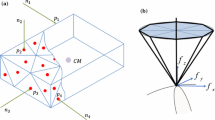Abstract
An efficient analysis of potential mating trajectories employs a two-dimensional approximation of the part geometry to obtain a reasonable approximation of the volume still remaining for the, as yet, unspecified gripper. This analysis is useful in determining the suitability of potential mating sequences when the actual robot and gripper to be used in the final assembly operations are unspecified. The complexity of the algorithm is analysed. Several examples of the application of the algorithm are provided to illustrate the algorithm's ability to choose between various gripper types and different mating trajectories.
Similar content being viewed by others
References
H. L. Welch.Robot Independent Assembly Sequence Planning, Doctoral thesis, Rensselaer Polytechnic Institute, Troy, New York, August, 1990.
L. S. Homem de Mello and A. C. Sanderson. “At correct and complete algorithm for the generation of mechanical assembly sequences”,IEEE Transactions on Robotics and Automation,RA-7(2), pp. 228–240, 1991.
L. S. Homem de Mello and A. C. Sanderson, “AND/OR graph representation of assembly plans”,IEEE Transactions on Robotics and Automation,RA-6(2), pp. 188–199, 1990.
H. Ko and K. Lee, “Automated assembling procedure generation from mating conditions”,Computer Aided Design,19(1), pp. 3–10, 1987.
T. L. De Fazio and D. E. Whitney, “Simplified generation of all mechanical assembly sequences”,IEEE Journal of Robotics and Automation,RA-3(6), pp. 640–658, 1987, and “Corrections”,RA-4(6), pp. 705–8, 1988.
T. L. De Fazio, D. E. Whitney, T. E. Abell, D. F. Baldwin, and M.-C. M. Liu, “An integrated aid for generating and evaluating assembly sequences for mechanical products”,IEEE Transactions on Robotics and Automation,RA-7(1), pp. 78–94, 1991.
S. E. Fahlman, “A planning system for robot construction tasks”,Artificial Intelligence,5, pp. 1–49, 1974.
N. Boneschanscher, H. van der Drift, S. J. Buckley and R. H. Taylor, “Subassembly Stability”, Proceedings American Association for Artificial Intelligence AAAI 88, Seventh National Conference on Artificial Intelligence, St. Paul, Minnesota, pp. 780–785, August 1988.
B. R. Fox and K. G. Kempf, “Opportunistic scheduling for robotic assembly”, Proceedings, IEEE International Conference on Robotics and Automation, St. Louis, Missouri, pp. 880–889, April 1985.
R. E. Fikes and N. J. Nilsson, “STRIPS: A new approach to the application of theorem proving to problem solving”,Artificial Intelligence,2, pp. 189–208, 1971.
G. W. Ernst and A. Newell,GPS: A Case Study in Generality and Problem Solving, Academic Press, San Diego, California, 1969.
D. Chapman, “Planning for conjunctive goals”,Artificial Intelligence,31, pp. 333–377, 1987.
A. Bourjault,Contribution à une Approche Méthodologique de l'Assemblage Automatisé: Élaboration Automatique des Séquences Operatoires, Thèse d'État, Université de Franche-Comté, Besançon, France, November, 1984.
J. Barber, R. A. Volz, R. Desai, R. Rubenfeld, B. Schipper and J. Wolter, “Automatic two-fingered grip selection”, Proceedings, IEEE International Conference on Robotics and Automation, San Francisco, California, pp. 890–896, April 1986.
L. De Floriani and G. Nagy, “A graph model for face-to-face assembly”, Proceedings, IEEE International Conference on Robotics and Automation, Scottsdale, Arizona, pp. 75–78, May 1989.
V. D. Nguyen, “Constructing stable grasps in 3D”, Proceedings, IEEE International Conference on Robotics and Automation, Raleigh, North Carolina, pp. 234–239, 1987.
J. W. Jameson and L. J. Leifer, “Automatic grasping: an optimization approach”,IEEE Transactions on Systems, Man, and Cybernetics,SMC-17(5), pp. 806–814, 1987.
R. C. Brost, “Automatic grasp planning in the presence of uncertainty”,International Journal of Robotics Research,7(1), pp. 3–17, 1988.
J. Pertin-Troccaz, “On-line automatic robot programming: a case study in grasping”, Proceedings IEEE International Conference on Robotics and Automation, Raleigh, North Carolina, pp. 1292–1297, April 1987.
R. A. Brooks, “Planning collision-free motions for pick-and-place operations”,International Journal of Robotics Research,2(4), pp. 19–44, 1983.
T. Lozano-Perez and M. A. Wesley, “An algorithm for planning collision-free paths among polyhedral obstacles”,Communications of the ACM,22(10), pp. 560–570, 1979.
S. H. Suh and K. G. Shin, “Robot path planning with distance-safety criterion”, Proceedings 26th Conference on Decision and Control, Los Angeles, California, pp. 634–641, December 1987.
O. Takahashi and R. J. Schilling, “Motion planning in a plane using generalised Voronoi diagrams”,IEEE Transactions on Robotics and Automation,5(2), pp. 143–152, 1989.
J. D. Wolter, “On the automatic generation of assembly plans”, Proceedings, IEEE International Conference on Robotics and Automation, Scottsdale, Arizona, pp. 62–68, May 1989.
J. H. Miller and R. L. Hoffman, “Automatic assembly planning with fasteners”, Proceedings, IEEE International Conference on Robotics and Automation, Scottsdale, Arizona, pp. 69–74, May 1989.
A. C. Sanderson and L. S. Homem de Mello, “Planning assembly disassembly operations for space telerobotics”,Proceedings of International Society for Optical Engineering: Space Station Automation III,851, pp. 109–115, 1987.
Author information
Authors and Affiliations
Rights and permissions
About this article
Cite this article
Welch, H.L., Kelley, R.B. The analysis of potential mating trajectories and grasp sites. Int J Adv Manuf Technol 8, 320–328 (1993). https://doi.org/10.1007/BF01783616
Accepted:
Issue Date:
DOI: https://doi.org/10.1007/BF01783616




